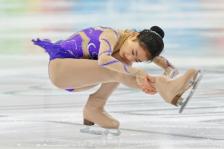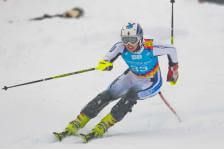How to Get Fit Like a Winter Olympian (Part 1)
The Winter Olympics are in full swing and the amazing bodies and athletic prowess of the competitors are on display. This week, learn how to get the balance of an ice dancer, the speed of a slalom skier, the butt of a bobsledder, the legs of a ski jumper, the core of a snowboarder, and the fitness of a hockey player.

Now it’s time to turn to the amazing bodies and athletic prowess of the winter Olympians, and learn how to get the balance of an ice dancer, the speed of a slalom skier, the butt of a bobsledder, the legs of a ski jumper, the core of a snowboarder, and the overall fitness of a hockey player.
Sponsor: This episode is brought to you by DailyBurn, the best fitness anywhere. Access online workout videos featuring a variety of programs, from tabata to interval training to yoga. Get the first 30 days free when you go to dailyburn.com/getfitguy.
This week, we’ll discuss how to get Olympian balance, speed and of course, that part about the butt. In Part 2 next week, we’ll cover the rest. So without further ado, let’s break the ice and jump into the snow, shall we?
How to Get Balance Like an Ice Dancer
There’s nothing quite like the enchantment of seeing the top-level ice dancers whip about on that slippery surface as if it were no big deal – especially when I routinely show off my “Bambi on Ice” impression at the local ice rink in my hometown of Washington state.
But even if we never quite have the moves of an ice dancer, we can all certainly benefit from the grace, injury prevention, and increased coordination that comes with having better balance.
In the episode 3 Ways to Get Better Balance, you learned that you can simply think of balance as your ability to maintain your base of support with minimal postural sway or collapse. In physics, something called a “line of gravity” is used to define balance. Specifically, better balance involves an increased ability to maintain your line of gravity over your base of support.
But in more basic Get-Fit Guy terms, balance is simply the ability to move your body and limbs around efficiently, precisely, and quickly while also being able to change direction without falling down.
Technically, maintaining balance requires coordination of 3 different sensory systems in your body:
-
The vestibular system, which consists of the sense organs in your head (primarily your ears) which regulate your equilibrium and give your brain directional information related to your head position.
-
The somatosensory system, which relies on nerves called “propriocepters” in your joints, along with the pressure and vibration sensors in your skin and your joints.
-
The visual system, which relies on your eyes to figure out where your head and body are in space, and also your location in space relative to other objects.
So for you to be properly balanced, each of these 3 components must be optimized. In other words, you need to have good eyes, good ears, and healthy joints. I’d highly recommend you go check out the full episode 3 Ways to Get Better Balance to learn everything there is to know about improving your sensory systems.
But for now, you can start by taking care of your ears (avoiding loud sounds and not holding your cell phone up to your ear), taking care of your eyes (taking screen breaks while staring at a computer and eating organic eggs or wild caught fish a few times a week), and taking care of your joints (doing single leg balancing drills).
How to Get the Speed of a Slalom Skier

So what’s a good exercise for you to get slalom skier speed?
Try this one-two combo move (which you can do anywhere – even at your office if nobody is watching): fast feet followed up with high jumps.
Here’s how to do it:
Start by simply running in place. Pick up one foot after another quickly (this is the fast feet part). Run 30 fast feet as fast as possible, then quickly transition to high jumps – which are exactly what they sound like. Simply squat down, swing your arms behind you, then jump as high as possible. Do just 5 of these, or as many as 10 if you really want to get huffing and puffing. Remember – speed and explosiveness is key to get the most bang for your buck out of this move.
How to Get the Butt of a Bobsledder
While you can get a ton of better butt tips by doing a quick search for “butt” over at QuickAndDirtyTips.come, there’s one move that’s especially useful to develop the type of butt a bobsledder gets while they’re throwing their body weight, hips, glutes, and thighs into the weight of that sled to get it moving to top speed.

I personally do walking lunges at my home, and try to go from my office to my bedroom and back, which is about 50 total feet of lunges. When I’m holding two 40lb dumbbells at my shoulders, that’s more than enough to get a quick butt burn.
One extra tip for lunges: Move slowly and deliberately, focusing on pausing for just a brief second when you’re in the middle of the lunge so you get some balance benefit from this move too.
I’ll bring you more awesome Olympic moves next week. In the meantime, try this game: When you see ice dancing or ice skating on TV, try balancing on one leg. When you see skiing or snowboarding, try your fast feet with high jumps. And when you see the bobsled or luge, do a few walking lunges. Think of it as fitness fun, and see how many exercises you can rack up over the course of this week!
See also: How to Get Fit While Watching TV
If you have questions about any of these exercises, on how to get fit like a Winter Olympian, or just want to talk more about the winter Olympics, then join the discussion over at Facebook.com/GetFitGuy.
Ice skater, skier, and bobsledders images courtesy of Shutterstock.
You May Also Like…






